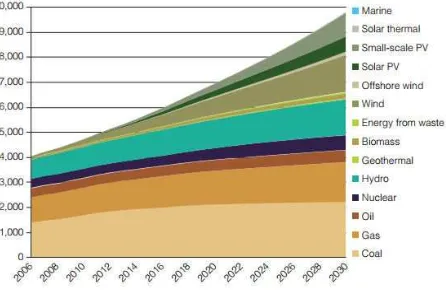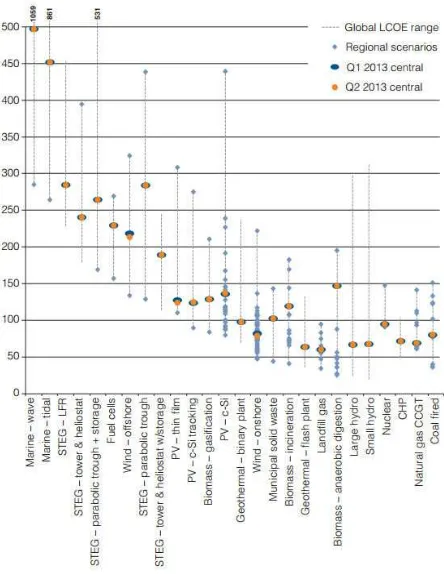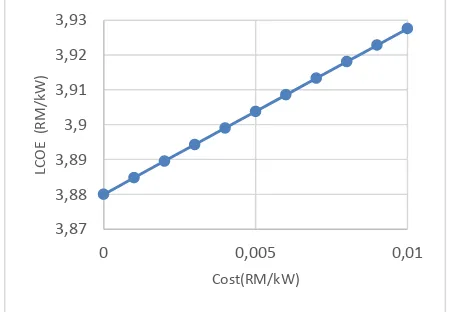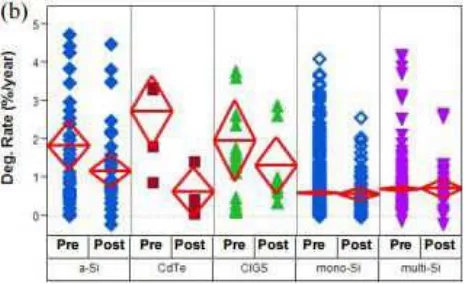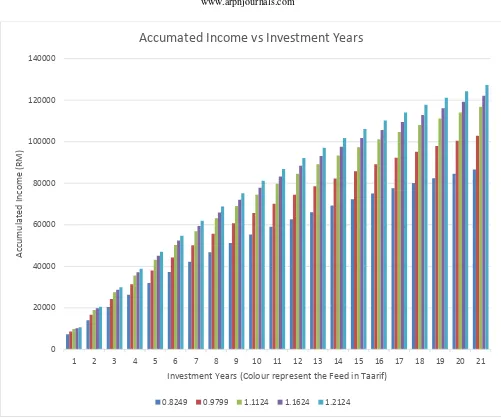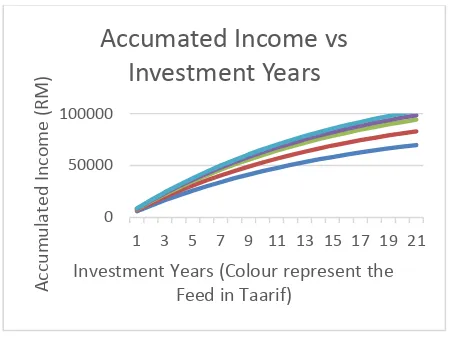PHOTOVOLTAIC ECONOMIC POTENTIAL FOR INVESTMENT
PORTFOLIO IN SOUTH EAST ASIA
Mohd Firdaus bin Mohd Ab Halim, Mohamad Haniff Harun, Khalil Azha Mohd Annuar, Arman Hadi bin
Azahar and Nik Azran bin Ab Hadi
Creative Innovation Technology Research Group, Faculty Teknologi Kejuruteraan, Universiti Teknikal Malaysia Melaka Durian Tunggal, Melaka, Malaysia
E-Mail: mohd.firdaus@utem.edu.my
ABSTRACT
This study is about the economic potential of solar photovoltaic (PV) potential in South East Asia particularly Malaysia that implementing FiT incentive. It is crucial from the perspective of private and individual pv energy provider to evaluate the economic potential of this type of energy investment. The economic indicator to be used is levelized cost of energy in RM/kW and payback period prediction in years. All the data for the determination of this indicator mostly from the authorized body and scientific standpoint. The alternative view of economic profitability is also applied while the capacity factor (CF) fluctuation due to unpredictable amount of solar radiation is determined based on the location. The indicator certainly can assist the energy investor to assess the potential and benefits according to their financial ability, period of investment while knowing the risk involved.
Keywords: photovoltaic, economic indicator, payback period.
1. INTRODUCTION
1.1 Energy demand
Demand for electricity stays flat in western country while marginally increasing in South East Asia. There are several factors that influence the dynamic of the energy market demand. The rise of electricity bills over the past 5 years urge the consumer to reduce energy consumption through managing the usage efficiently. The uncertainty in economic outlook also contributes to the slow energy demand. These situations impose direct impact towards the renewable energy industries.
Figure-1. Forecast of the cumulative installed power generation capacity (GW).
1.2 Free and clean: photovoltaic energy
Photovoltaic energy is considered to be the future of the energy industry because it is known to be environmentally friendly and uses free infinite energy source from the sun. Unfortunately the cost of producing
photovoltaic industry, this is just temporary. One day the fossil fuel may be depleted and as the photovoltaic technology expands, the cost of this energy would also decrease.In this work, we determined the Levelized Cost of Solar PV in Malaysia with justifiable assumption. Other LCOE calculation techniques and external factor are also applied. A range of LCOE is then identified and compared to the FiT (Feed in Taariff) offered by SEDA. The research would give an indication of the economic potential as a developing nation with good infrastructure such as Malaysia to both the PV service provider and the potential PV generation entrepreneur.
1.3 Clean energy demand
Figure-2. Levelized cost of renewable energy in the second quarter of 2013. (World Energy Council, 2013).
2. METHOD
Based on the previous study made by (Bengt Stridh et al, 2014) in Europe, the LCOE calculation requires a lot of assumption due different retail price of energy, self consumption percentage, fees from the energy distributor, energy trading price fluctuation, various fees by the energy authority and many more. The distinct between these two studies is that in Europe the cost of PV is reduced by the government subsidy and the energy is a commodity for trading.
In South East Asia, the renewable energy sector is growing rapidly due to various incentives provided by the government. In Malaysia, Thailand, Indonesia and Philipines the Feed-in tariff was one of the key incentive to promote growth in PV energy sector in the region. This region also does not trade electricity as in Europe. Hence, the LCOE calculation is less complicated and become much more accurate when only single country information, Malaysia is used in the calculation.
2.1 Solar PV cost based on LCOE
The levelized cost of energy, LCOE is an economic indicator used by the power industry to obtain the cost of generating one kilowatt-hour (kWh) of electricity averaged over the lifetime of the power plant. The LCOE is a function of fixed cost and annual cost shown in equation 1.
�� =��� � � � � � (1)
For a power plant that uses heat as the source for the prime-mover, the total fixed cost is the sum of initial power plant costs and the product of Heat Rate in (Btu/kWh) and Fuel in (RM/Btu). The levelized annual cost is a product of levelizing factor and the sum of all raw cost annually and the operational and maintenance cost. This equation is applied to to calculate LCOE for PV in Malaysia. Malaysia is chosen for this study since it is the 3rd largest solar module manufacturing hub in the world hence suitable candidates for cost competitiveness study.
2.2 LCOE of PV in Malaysia
In Malaysia, the cost breakdown of a residential PV system is given in Table-1 shown below (Sustainable Energy Development Authority, 2014). The fees for acceptance test and reliability run test supervised by the authorized body is shown in Table 2 (Sustainable Energy Development Authority, 2016). The variable cost of PV can come from annual maintenance. The maintenance cost annually by reputable company can be as high as USD 0.075/kW annually. If the panel is easily accessible, the owner can perform their own maintenance.
Table-2. Fees for acceptance test and reliability run test supervised by SEDA.
Procedure Capacity
Testing and commissioning to be witnessed by an
Authority’s representative Fees (RM) Systems less than or equal to 12
kWp and systems less than or equal to 12 kWp (use of microinverter in the PV system)
≤ 12 kW No
Systems greater than > 12 kW and less than 72 kWp
> 12 kW but
< 72 kW Yes 3,710
Systems equal to or greater than 72 kWp and up to 425 kWp
≥ 72 kW but
≤ 425 kW Yes 5,300
Systems greater than 425 kWp > 425 kW Yes 7,420
Table-3. List of assumption and justification.
Parameters Assumption values Source/ Justification
Plant cost RM 8.5/W SEDA
Annual Cost
Nil 0.5% - 1% of installation cost
Ideal case
Maintenance, monitoring cost
Lifetime of the PV system, 21 years SEDA
Plant Capacity 4kW SEDA
Discount rate, d 8% Highest deposit rate among Malaysia bank.
Escalation Rate 2.4% Inflation rate in from National Bank Malaysia
Sunlight hours/day 0.25 hours/day Malaysia Meteorology Service
Tax and Fees Nil 4kW capacity-zero fees
LCOE range can be very broad. A number of assumptions have to be made to simplify the calculation. Table 3 listed all the parameters required to calculate LCOE and the justification or source of the data(Energy Market Authority and Building and Construction Authority Handbook, 2016).
If the ideal case is considered, the LCOE values yield RM 3.88/kW for 4kW rated solar system. The LCOE values for the non - ideal case is presented graphically below.
2.3 Payback period based on NPV
It is unusual to use Net present value (NPV) as an indicator for an investment in energy industry. NPV can be used if the initial investment and annual profit are known. Equation (2) shows the general equation of NPV.
� = ∆� × � �, � − ∆ (2)
Where PVF is the present value function of d, discount rate and n, the number of years of the investment period.
∆P is the initial investment of the project. NPV by taking the same discount rate and investment period in Table 4(Sustainable Energy Development Authority, 2016) with Feed in Tariff (FiT) of RM 0.8249/kW and 8,760 hours of full sunlight a year yield RM 54969.48.
3,87 3,88 3,89 3,9 3,91 3,92 3,93
0 0,005 0,01
LC
O
E
(
R
M
/k
W
Table-4. Feed in Taarif in Malaysia.
Based on NPV rules, the positive value shows that the investing in this project is profitable. Simple Payback Period (SPP) is 4.7 years. The Internal Rate of Return (IRR) from the precalculated present value function in Table-5 is 19%-21%.(Masters and Gilbert M, 2013).
Table-5. Present value function to help estimate the internal rate of return.
2.4 Payback period based derived from LCOE
In the other hand, the payback period that can be derived from LCOE is given by the formula below.
� − ∑�=1 �×�1+ ��1− �−1� − �� = 0 (3)
Where
I = initial investment cost, P = payback period in years
V = electricity feed in tariff, first year output (8,760 hours,
d = degradation rate (0.5%/year),
a = annual cost, I is year and rate is discount rate of 6%.
2.5 Result from payback period based derived from LCOE
Figure-4 graphically shows the accumulation of income after n years of investment in PV energy for 4kW
PV capacity. The colors represent the different Feed in Tariff based on bonus level in Table-4. From this graph, the energy investor can easily predict how long their investment in PV energy can come to fruition. The range of the initial cost for 4kW PV system is between RM 34,000 to 50,000. Based on the graph, the payback period for this case is 5 -6 years. This method of calculation in much more accurate compared to the NPV method just because it includes the PV energy degradation rate in the calculation. According to (Dirk C. Jordan and Sarah R. Kurtz, 2013), the mean degradation rate of PV system over 40 years of the data is 0.8% and median of 0.5%.
Figure-4. degradation rate by technology (Dirk C. Jordan and Sarah R. Kurtz, 2013).
Figure-5 shows the degradation rate of by all known module technology. Nevertheless the difference is very minimal. The calculation so far only applicable for a PV capacity of 12 kW and below. As the capacity increase, the PV cost is decreased. The income based on FiT also decreases while the tax and fees increase.
2.6 PV energy output
Figure-5. Accumulation of income after n years of investment in PV energy for 4kW PV capacity.
Table-6. Daily mean solar radiation reading at low lands and Cameron Highland.
Low land area
(MJm-2) Cameron (MJm -2
)
October 14.25 13.24
November 14.81 12.38
December 11.31 15.82
January 17.36 16.86
Februari 10.93 18.64
March 11.91 20.07
The conversion from Wm-2 to MJm-2 by simple approximation is Wm-2 = 11.57 MJm-2 (J.A. Engel-Cox1, N.L. Nair and J.L. Ford, 2012). Assuming that the PV energy contractor uses this data to rate their PV module capacity, it is safe to use the maximum mean daily as the
and 7 shows the predicted annual income versus investment years in two locations.
Figure-6. Accumulated Income over 21 years with CF of 0.554 (mean lowland).
0 20000 40000 60000 80000 100000 120000 140000
1 2 3 4 5 6 7 8 9 10 11 12 13 14 15 16 17 18 19 20 21
A
cc
u
m
u
lat
e
d
In
co
m
e
(
RM)
Investment Years (Colour represent the Feed in Taarif)
Accumated Income vs Investment Years
0.8249 0.9799 1.1124 1.1624 1.2124
0 10000 20000 30000 40000 50000 60000 70000
1 3 5 7 9 11 13 15 17 19 21
A
cc
u
m
u
lat
e
d
In
co
m
e
(
RM)
Figure-7. Accumulated Income over 21 years with CF of 0.805 (Cameron).
The summary of the payback period for all the consideration discussed earlier is shown in Table-7.
Table-7. Payback period summary.
Payback period impact towards the profit and pay back period. This study deliver justified information and conclusion that the energy investor should look into before dive into the energy market. Nevertheless, the economic impact should not be the sole reason for the energy investor to invest. In Europe, the trend of green energy is growing rapidly because most of the citizen feel the responsibility of creating the world a greener place to live but if the profit is there, then it should be considered as bonus to them.
ACKNOWLEDGEMENT
The author would like to thank Universiti Teknikal Malaysia Melaka for the financial support through short term research grant towards this research.
REFERENCES
World Energy Council. 2013. Cost of Energy Technologies. pp. 9-10.
Bloomberg New Energy Finance/UNEP. 2016. Executive Summary, Global Trends in Renewable Energy Investment. pp. 12-19.
Bengt Stridh, Stefan Yard, David Larsson and Björn Karlsson. 2014. Profitability of PV electricity in Sweden, IEEE 40th Photovoltaic Specialist Conference (PVSC), pp.1492 - 1497
Sustainable Energy Development Authority (SEDA). 2014. National Survey Report of PV Power Applications in Malaysia. Photovoltaic Power System Programme.
Sustainable Energy Development Authority (SEDA). 2016. Guidelines And Determinations Of The Sustainable Energy Development Authority MalaysiaMalaysia Guideline.
Energy Market Authority and Building and Construction Authority. 2016. Handbook for solar photovoltaic (PV) systems ISBN: 978-981-08-4462-2.
Sustainable Energy Development Authority (SEDA), FiT Rates for Solar PV Community, 2016 (21 years from FiT Commencement [Online]. Available:http://seda.gov.my/.
Masters, Gilbert M. 2013. Renewable And Efficient Electric Power Systems, 2Nd Edition. John Wiley & Sons.
Dirk C. Jordan and Sarah R. Kurtz. 2013. Photovoltaic Degradation Rates - An Analytical ReviewNational Renewable Energy Laboratory (NREL). 21(1): 12-29.
Green Rhino Energy, Annual Variation of solar insolation
2013. [Online]. Available:
http://www.greenrhinoenergy.com/solar/radiation/empiric alevidence.php.
Ministry of Science and Technology (MOSTI), Monthly Weather Bulletin. 2016. Official Website of Malaysia Meteorogical Department, [Online] Available: www.mosti.gov.my/.
J.A. Engel-Cox1, N.L. Nair and J.L. Ford. 2012. Evaluation of Solar and Meteorological Data Relevant to Solar Energy Technology Performance in Malaysia, Journal of Sustainable Energy and Environment. 3:
115-Investment Years (Colour represent the Feed in Taarif)
